In this guide you will learn the most important key metrics that you need to monitor and optimize for to get the most profits out of your Facebook Ads campaigns. Whether you are an affiliate or a media buyer in general, these metrics are crucial.
To make your campaigns profitable in the long run, it’s key to regularly monitor and optimize important Facebook ad metrics.
To be able to measure your results properly, you need to understand which metrics matter the most and why they’re crucial for your campaign’s success.
These metrics can vary based on what kind of campaign you are running, so let me break down the KPIs (Key Performance Indicators) you should focus on for different campaign objectives.
Page Like Campaigns
Page Like campaigns are the fastest and best way to grow your follower base. These ads encourage users to “like” your page, helping them see more of your content.
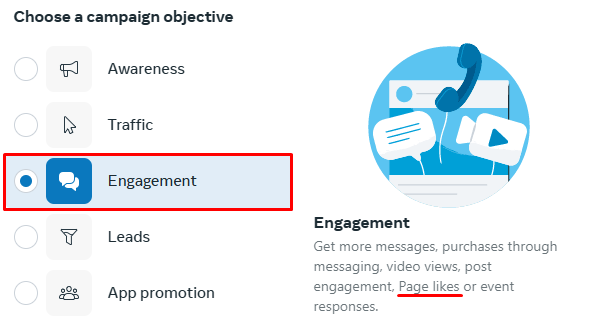
Since Facebook has become a “pay to play” space for businesses, running page like campaigns is essential these days for building your audience and expanding your reach. These ads are valuable for increasing followers, boosting reach, and enhancing brand awareness.
Page like campaigns need a dedicated monthly budget rather than a set one time budget. We recommend at least $150 per month, as this amount has proven to be effective in our experience.
For budgeting, I recommend considering these options:
- Good: $150 per month
- Better: $300 per month
- Best: $500 per month
The primary Facebook ad metric to watch for page like campaigns is engagement, specifically, the actual number of page likes. The goal here is to maximize page likes within your budget and reduce the cost per page like to get more followers for every dollar spent.
Other key metrics for page like ads include reach, cost per page like, and relevance score. Facebook prioritizes showing ads that are most relevant to users, so relevance impacts ad delivery.
The relevance score, ranging from 1 to 10, reflects the positive and negative feedback your ad receives from the target audience. Higher scores result from positive engagement, while actions like hiding or reporting an ad lower the score.
This score is updated as people interact with the ad, helping you reach the right audience while ensuring a better experience for everyone.
Boosted Post Campaigns
The fastest way to increase engagement (likes, reactions, comments, shares) on your posts is by running Boosted Post campaigns.


Recent Facebook algorithm changes have made it challenging for everyone to achieve organic reach. Without boosting, posts typically reach only about 1% of your page’s followers organically.
Budgeting for Boosted Posts
How much you spend on boosting depends on the post’s purpose and the level of reach you want. For high priority posts, like contests or giveaways where you aim for maximum reach, I suggest a larger budget, such as $50-$100, running for about a month. For standard posts aimed at improving engagement or brand awareness, a budget of $5-$10 over 3-5 days is usually okay.
Key Metrics for Boosted Posts
For boosted posts, the main metrics to track are post engagement types, such as likes, reactions, comments, and shares:
- Likes and Reactions: High like counts add credibility to your post, encouraging even more engagement.
- Comments: The number of comments reflects the relevance and appeal of your content.
- Shares: Shares indicate audience loyalty and their confidence in recommending your brand.
Tracking these metrics helps you to learn about audience interest and interaction, which goes beyond just follower count. High engagement means your content is resonating with your audience, which builds credibility over time.
Additional Metrics
Other important metrics include reach, page likes, and cost per post engagement. When you boost a post, you can see its paid reach (in addition to organic reach) by hovering over the orange bar under the post. Paid reach reflects how many people the boosted post has reached, which is a good indicator of your campaign’s visibility.
Boosted posts also give users the option to like your page, increasing your audience and improving the chances of organic reach in the future. This gradual increase in page likes expands your reach, helping more people see your content organically over time.
Awareness/Reach Campaigns
Another effective way for boosting engagement and brand awareness is running a reach or brand awareness campaign. Both options are found under the “Awareness” category in Facebook’s Ads Manager, making them ideal for building recognition and connecting with a wider audience.
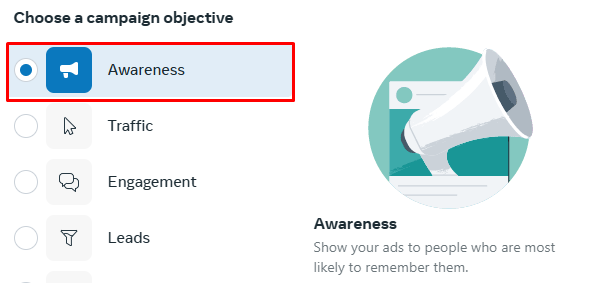

Reach Campaigns
A reach campaign aims to show your ad to as many people as possible. This option works well for spreading a key message broadly, think of it as maximizing your audience’s exposure.
Reach ads are ideal for actions like “get directions” to a location, “call now” to contact your business, or “learn more” for additional details. They’re also good for those who don’t have a website or landing page to direct people to.
Brand Awareness Campaigns
While similar to reach ads, brand awareness campaigns go further by targeting people more likely to engage with your brand. Whereas reach ads focus on reaching a large amount of people, brand awareness ads focus on quality, prioritizing prospects who would genuinely be interested in your business.
Budget Recommendations
Just like page like campaigns, reach and brand awareness campaigns require a dedicated monthly budget. Based on our experience, $150 per month is a solid minimum starting point for effective results. My recommended budget tiers include:
- Good: $150 per month
- Better: $300 per month
- Best: $500 per month
Key Metrics to Track
For both types of campaigns, the most critical metrics are:
- Reach: The total number of people who see your ad.
- Cost per 1,000 People Reached (CPM): This helps track the cost-effectiveness of your ad spend.
- Video Metrics (if using video ads): Metrics such as video views, average watch time, and percentage watched.
- Relevance Score: This score measures how well your ad resonates with your audience based on their feedback, helping Facebook serve ads that align with user interests.
These metrics allow you to compare how well your ads are performing, adjust your strategy, and optimize your budget for better engagement and awareness.
Traffic Campaigns
Traffic ads are the option if you want to redirect people to a specific website or landing page. Unlike ads geared toward selling a product or service, traffic ads work best for actions like “learn more,” allowing potential customers to explore your site or landing page to get more information.
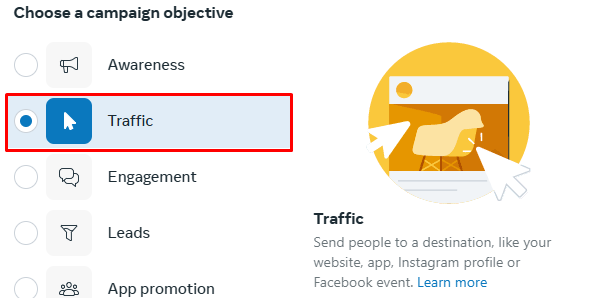

Budget Recommendations
Like page like ads, traffic ads need a dedicated monthly budget. I suggest starting with at least $150 per month to see effective results. I recommend considering these budgets for starting out:
- Good: $150 per month
- Better: $300 per month
- Best: $500 per month
Key Metrics for Traffic Ads
When running traffic ads, keep an eye on these KPIs:
- Link Clicks: This measures how many people clicked on the ad to visit your site, showing clear interest.
- Cost per Link Click: Tracking this cost helps ensure efficient ad spending. A target of under $3 per link click is ideal for keeping costs low while maximizing traffic.
- Link Click-Through Rate (CTR): A higher CTR indicates your ad is effective at prompting action.
- Reach: This measures the number of people who saw your ad.
- Relevance Score: Facebook uses this score to show ads that match user interests, helping your ad perform better with the right audience.
By tracking these metrics, you can analyze how well your traffic ads are performing and make adjustments to increase site visits without exceeding your budget.
Conversion Campaigns
If you’re in affiliate marketing or eCommerce, you probably want to launch conversion campaigns ASAP. These campaigns are for promoting products or services, as they allow you to track conversions directly from your campaigns.
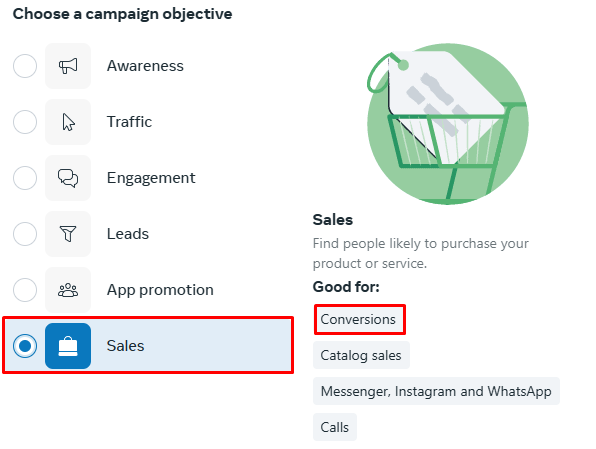

For products, conversion campaigns help drive traffic to your online store, convert viewers into customers, and measure key metrics like revenue per conversion and average cost per purchase. For services, you can use conversion ads to have people book appointments, register for events, or fill out contact forms on a landing page.
When someone fills out a form, they become a lead, providing you with contact information and showing genuine interest in your business. You can then follow up with them by phone or email to discuss your services.
Budget Recommendations
For conversion campaigns you typically need a higher budget compared to other campaigns types, since your goal is to generate sales or leads and your goal is to make more money then you spend on ads. In most cases if you are just starting out with your first campaigns, you spend at least $20 per day per campaign, which is the bare minimum I think. The more you can spend the better.
Key Metrics for Conversion Ads
For conversion campaigns, the primary metric is conversions, whether it’s leads or purchases.
Other important metrics to track include:
- Conversion Value and ROAS: For tracking the revenue earned relative to your ad spend.
- Cost per Result: Measures cost efficiency.
- Link Clicks: Indicates interest and drives traffic to your site.
- Cost per Link Click: Helps manage costs per click.
- Click-Through Rate (CTR): Higher CTRs show effective ads.
- Relevance Score: Facebook’s rating of ad relevance based on user feedback.
Focusing on these metrics helps you monitor how effectively your conversion ads turn interest into action, maximizing ROAS (Return On Ad Spend.)
Lead Campaigns
Lead generation ads are great for collecting email addresses even if you don’t have a website or landing page for form submissions. These ads allow you to capture leads directly within the Facebook app or browser, using lead forms.
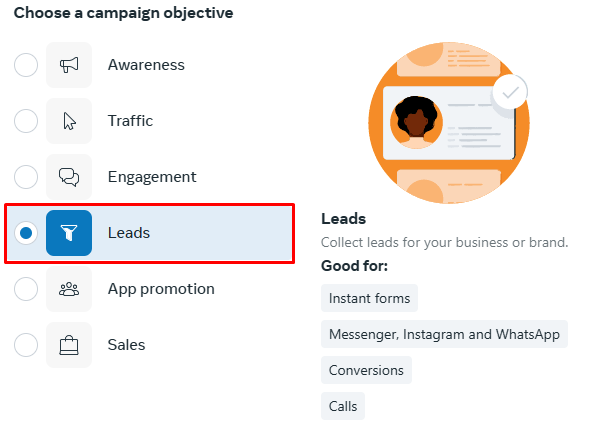

Lead gen ads make it easy to collect all the information you need, as they open a pop-up form that users can fill out without leaving Facebook. You can customize this form to gather specific details, and capture contact information from people interested in your business.
Key Metrics for Lead Generation Ads
The primary metric for lead generation ads is the number of leads generated. Other key indicators you should focus on are the following:
- Cost per Lead: To measure the efficiency of each lead generated.
- Link Clicks: Shows the level of interest in your ad.
- Cost per Link Click: Helps manage the cost of driving traffic.
- Link Click-Through Rate (CTR): Indicates ad effectiveness.
- Relevance Score: Facebook’s rating based on user interaction.
Campaign Optimization
While each campaign type and objective might be unique, the most important Facebook ad metrics are usually the same. Once you’ve identified the primary KPIs for your campaign, it’s time to start optimizing.
Steps to Optimize Your Facebook Ads
The methods for optimization depend on the campaign goal, but like the metrics, there are common areas to focus on. The first place to start is with your targeting.
Audience Targeting
Facebook offers detailed targeting options, allowing you to define your audience by factors like age, location, interests, and behaviors. Fine tuning your audience targeting can impact key metrics like reach, cost per result, and relevance score. It may take several adjustments to find the best combination for optimal results.
A/B Split Testing
When you first launch ads, it’s a good idea to use A/B split testing. This involves pairing different text versions with various images, to see which combination performs best. A common approach is to test three different images with three different texts. Or 1 images with 5 different angles.
Monitoring Regularly
Keep a close eye on ad performance from the start. Track the main KPIs and compare these to your campaign goals. After some time, identify the underperforming ads, those with higher costs or lower reach, and get rid of them. This allows you to allocate more of your budget toward the ads that are generating the best results.
By consistently monitoring and optimizing these areas, you’ll increase the chances of running a profitable campaign in the long run.
Conclusion
I know there’s been a lot of information in this article, but don’t worry if it feels overwhelming! Just focus on the section that applies to the campaign you’re running or the one you want to run.
Remember to keep an eye on the key Facebook ad metrics we covered, and make sure you’re optimizing your ads regularly. By monitoring your results and tweaking your campaigns, you’ll stay on the path to success!
Did you like this post? Please share it with friends to support this blog